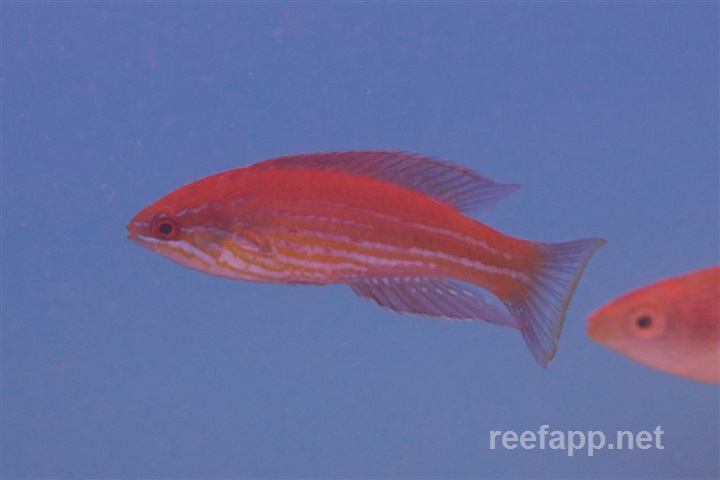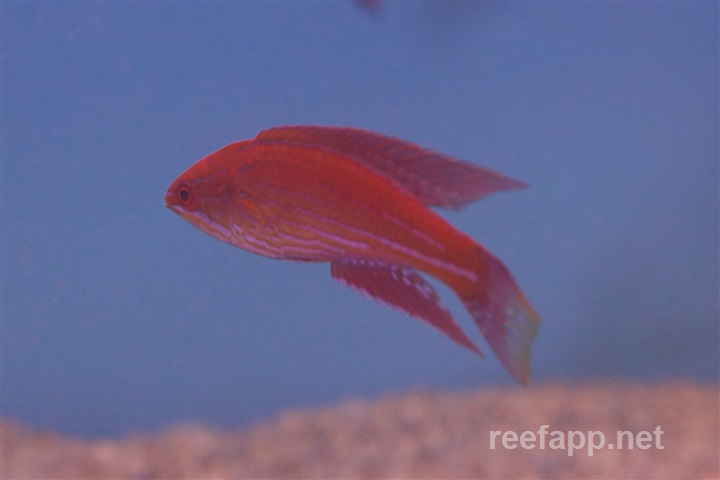Paracheilinus angulatus


| Latin name | Paracheilinus angulatus - Randall & Lubbock, 1981 |
|---|---|
| Local name | Angular flasher |
| Family | Labridae - Paracheilinus |
| Origin | Australia, Indonesia, Central/West Pacific |
| Max length | 7 cm (2.8") |
| Minimum volume |
200 l (53 gal) |
|---|---|
| Hardiness |
Average |
| Suitable for aquarium |
Suitable with care |
| Reef safe |
Always reef safe |
| Aggressiveness | Might be aggressive towards similar species |
| Recommended |
Small crustaceans (Krill, mysis, artemia...) Zooplankton (Cyclops, pods...) |
|---|
This species is known to jump out of open aquaria.
This species must be fed with an appropriately varied diet.
This species is very sensitive during transportation and acclimatizing into the aquarium.
These fish may well hide themselves for a while, whilst getting acclimatized.
Do not disturb the fish while acclimating because it will prolong the process.
This fish requires feeding several times a day, especially when newly added.
When the fish can find its natural food in the aquarium it requires less frequent feeding.
This species needs good hiding places, for example, between live rocks.
This species comes in multiple color variations which can make identification problematic.
This species functions best as a pair (one male, one female), or one male with several females.
This species can change gender from female to male.
When a male is needed, a female changes sex and takes on the role.
This species can be aggressive when kept together with fish that are very similar, or if they are not provided with adequate space.
Recognized by the sharp edged dorsal fin and the missing filaments.
Flasher Wrasses (Paracheilinus) are generally very colourful and spend most of their time out in the water column. They are peaceful and a little shy and therefore shouldn't be kept with aggressive species.
Males are normally more eye catching and may have longer filaments on their dorsal fin. In captivity it can be tricky to keep their colour and they need to be provided with a variety of high quality foods.
They are not normally very choosy and eat most foods, although it can take a day or two before they start eating, when they are first introduced.
When these Wrasses are kept in a group of several females and one or two males, the latter will show off their colours more often. If the tank is less than 125 gal (500 liters) only one male should be kept.
At night they sleep in a mucus covered cocoon between rocks.
Several species in this genus resemble each other closely, it is difficult to distinguish them. In practice this is not a problem as they resemble each other also closely in their behaviour and demeanour. There are also hybrids between the species which makes distinguishing them very challenging, as well.
When one chooses these fish it pays to check the area around the mouth, as they can be injured during transport, which can lead to infections.
It is also important to make sure they feed actively.
Wrasses are nearly always seen in reef aquaria, since many of the species are both attractive and useful in battling a range of unwanted invertebrates like i.e. flatworms, pyramide snails.
These fish live of everything from zooplankton to large crustaceans, sea urchins and the like.
The needs and behaviour of Wrasses vary greatly, so it is vital to familiarize oneself with the specific species before buying one.
| Distribution | Western Central Pacific: Philippines. Also reported from Indonesia. |
|---|---|
| English common names |
Royal flasher-wrasse Angular flasher |
Bob Fenner. Flasher Wrasses, the Genus Paracheilinus - Wet Web Media - (English)
Hiroyuki Tanaka. 2006. Flasher Wrasses: Recently Recognized in the Hobby - Reefkeeping Magazine - (English)
Scott W. Michael. 2009. Wrasses and Parrotfishes (Reef Fishes Series Book 5) - TFH Publications / Microcosm Ltd. - (English)

